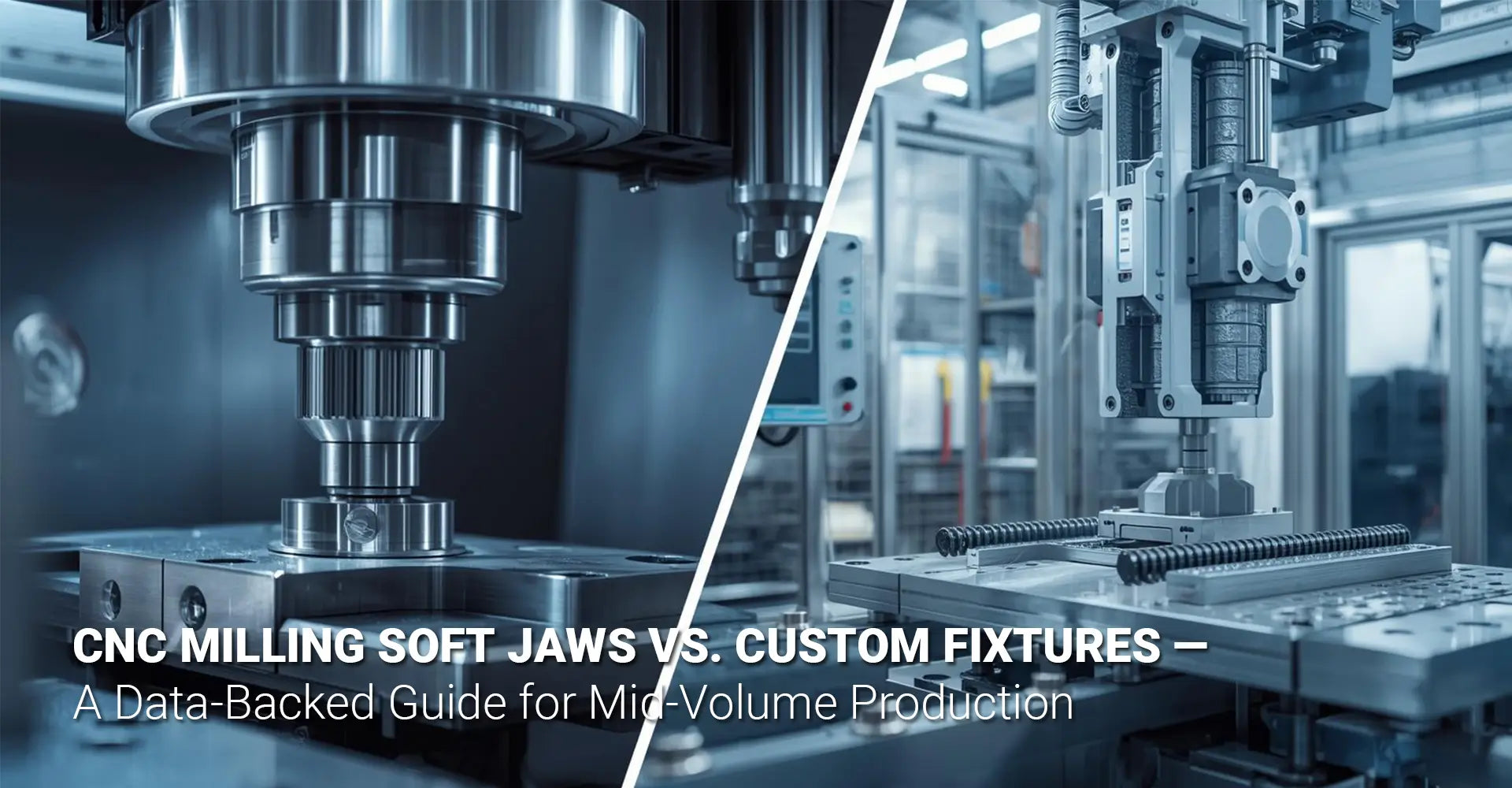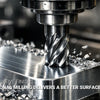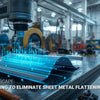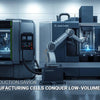Soft Jaws vs. Custom Fixtures: Which Workholding Solution Actually Saves You Money?

Soft Jaws vs. Custom Fixtures: Which Workholding Solution Actually Saves You Money?

Quick Answer: At a Glance Comparison
| Factor | Soft Jaws | Custom Fixtures |
|---|---|---|
| Initial Cost | $50-$200 per set | $1,500-$4,000+ per fixture |
| Setup Time | 2-4 hours (machining jaws) | 15-60 seconds (load part) |
| Best For Batch Size | 1-250 parts | 250+ parts |
| Precision Capability | ±0.001" (0.025mm) | ±0.0005" (0.013mm) |
| ROI Timeline | Immediate | 500-2,000+ parts |
Why Machine Shops Struggle With This Decision Every Day
Every CNC machining business faces the same critical question when planning production runs. Should you invest time machining soft jaws for your vise, or should you spend thousands on a dedicated custom fixture? This decision directly impacts your profit margin, machine utilization, and competitive pricing. Moreover, choosing the wrong workholding method can silently drain your resources for months without you realizing it.
The Simple Truth About Workholding Economics
Here's what you need to know right now: Your batch size and cycle time determine everything. For runs under 100 parts with simple geometry, soft jaws almost always win. However, when you're producing 500+ parts with complex shapes or tight tolerances, custom fixtures typically deliver better economics. The crossover point depends on your specific machine hour rate and the time savings per cycle.
Understanding the Stakes
Before diving into technical details, let's acknowledge why this matters. Many shops make workholding decisions based on gut feeling or outdated assumptions. Consequently, they either waste money on expensive fixtures they didn't need or lose profit by using soft jaws when a fixture would have paid for itself in the first 200 parts. Therefore, understanding the true economics helps you make data-driven decisions instead of guesses.
Table of Contents
- Why Does Your Workholding Choice Matter More Than You Think?
- What Are Soft Jaws and When Do They Make Sense?
- What Makes Custom Fixtures Worth the High Price Tag?
- How Do You Calculate the Breakeven Point Between Soft Jaws and Custom Fixtures?
- Which Workholding Method Delivers Better Precision and Repeatability?
- What's Your 5-Step Decision Checklist for Choosing the Right Workholding?
- Conclusion
Why Does Your Workholding Choice Matter More Than You Think?
Most machine shop owners focus on cutting tools, speeds, and feeds when trying to improve profitability. However, they often overlook the massive impact of workholding decisions on their bottom line. In fact, workholding can account for 15-30% of total machining time on complex parts.
The Hidden Cost Categories You're Probably Ignoring
When evaluating CNC milling soft jaw vs custom fixture options, you need to consider three distinct cost categories. First, there's the setup cost – the time and materials needed to create or install your workholding solution. Second, you have cycle time impact – how long it takes to load, clamp, and unload each part. Finally, there's the quality cost – scrap rates, rework, and inspection time resulting from workholding inconsistencies.
Real Numbers From the Shop Floor
Let's look at a real example from automotive manufacturing. A shop was producing 300 aluminum brackets per month using soft jaws. Each part required 8 minutes of machine time, but loading and positioning took 90 seconds per cycle. By switching to a custom fixture, they reduced load time to 20 seconds per part. Over 300 parts, this saved 350 minutes of operator time monthly – nearly 6 hours of labor that could be redirected to value-added work.
Additionally, the fixture eliminated the need to re-machine soft jaws every time they wore out or when switching to a new batch. This saved approximately 3 hours of machine time per month that was previously spent on non-productive jaw preparation. When you multiply these savings by 12 months, the economics become crystal clear.
What Are Soft Jaws and When Do They Make Sense?
Soft jaws are replaceable aluminum or mild steel jaw plates that mount onto standard CNC vise hard jaws. Unlike fixed hard jaws, you machine these soft jaws to match your specific part geometry, creating a custom grip for each job. This approach offers incredible flexibility without requiring expensive tooling investment.
The Sweet Spot for Soft Jaw Applications
Soft jaws excel in specific scenarios. They're perfect for prototype work, small production runs, and shops that handle diverse part mixes with frequent changeovers. When to use soft jaws becomes obvious once you understand their economic profile: they make sense when your batch sizes range from single prototypes up to about 200-250 parts, depending on cycle time.

Breaking Down the True Cost of Soft Jaws
A proper soft jaw cost analysis reveals both obvious and hidden expenses. The aluminum blank typically costs $40-$80 for a standard 6" vise set. However, the real cost lies in preparation time. Machining the jaws requires 1-2 hours of CNC time, including programming, setup, and actual cutting. At a machine hour rate of $75-$150, you're looking at $75-$300 in total cost per jaw set.
Furthermore, aluminum soft jaw machining demands careful attention to detail. You need to establish proper work coordinates, machine the jaw serrations, and create the part-specific profile. Each time you make a mistake or need to adjust the geometry, you're adding cost. Many shops underestimate this engineering time when calculating their true soft jaw economics.
The flexibility factor also matters significantly. With custom CNC milling services, soft jaws let you quickly adapt to design changes without scrapping expensive fixtures. If your customer revises the part geometry, you simply machine a new set of jaws rather than rebuilding an entire fixture. This adaptability proves invaluable for low volume workholding solutions in development environments.
What Makes Custom Fixtures Worth the High Price Tag?
Custom fixtures are precision-engineered workholding devices designed specifically for one part number. Unlike universal vises with soft jaws, these fixtures incorporate dedicated locating surfaces, clamping mechanisms, and often include built-in error-proofing features. They represent a significant capital investment but offer unmatched speed and repeatability.
When the Investment Actually Pays Off
The dedicated fixture cost typically ranges from $1,500 for simple designs to over $10,000 for complex multi-station tombstones. Despite these high numbers, fixtures become economically attractive when you're running medium-to-high volumes of identical parts. They particularly shine when part geometry makes soft jaw clamping difficult or impossible.

Understanding the Total Ownership Picture
Custom fixture ROI calculations must account for the complete lifecycle. Beyond initial design and fabrication costs, consider maintenance requirements, storage space, and potential modification needs if the part design changes. However, well-designed fixtures can last for tens of thousands of cycles with minimal maintenance.
The speed advantage cannot be overstated. While soft jaws might require 60-90 seconds to load and indicate a part, a good fixture reduces this to 10-20 seconds. For industrial machinery components running in batches of 500+ parts, this time savings translates directly to throughput and capacity.
Design costs typically run $500-$1,500 depending on complexity. Then you have fabrication costs, which vary based on materials and precision requirements. A fixture using standard steel plates with simple locators costs far less than one requiring hardened and ground surfaces with adjustable clamps. Additionally, if your fixture needs to work with various CNC metals and plastics, the design complexity increases accordingly.
Maintenance represents another consideration. Unlike soft jaws that you simply replace when worn, fixtures require cleaning, inspection, and occasional replacement of wear components like locating pins or clamp pads. However, this maintenance cost typically remains minimal compared to the recurring cost of machining new soft jaws.
How Do You Calculate the Breakeven Point Between Soft Jaws and Custom Fixtures?
Understanding milling fixture economics requires a straightforward calculation framework. The breakeven point occurs when the total cost of using soft jaws equals the total cost of using a custom fixture. This calculation helps you make objective decisions based on your specific production scenario.
The Breakeven Formula Explained Simply
Here's the basic formula:
Breakeven Quantity = (Fixture Cost - Soft Jaw Cost) ÷ (Soft Jaw Time Cost per Part - Fixture Time Cost per Part)
Let's work through a real example. Assume your fixture costs $3,000 and soft jaws cost $150. Your machine hour rate is $100. With soft jaws, loading takes 90 seconds per part. With a fixture, loading takes only 15 seconds per part.
Step-by-Step Calculation Methodology
First, calculate the time savings per part. In our example, you save 75 seconds per cycle (90 - 15 = 75 seconds). Converting to hours: 75 seconds ÷ 3,600 seconds = 0.0208 hours per part.
Next, multiply by your machine hour rate to find the cost savings per part. At $100 per hour, you save $2.08 per part in cycle time. Now apply the formula:
Breakeven = ($3,000 - $150) ÷ $2.08 = 1,370 parts
This means after producing 1,370 parts, the custom fixture pays for itself entirely. Every part beyond this point represents pure savings. However, remember that this calculation assumes consistent production volume. For workholding for medium volume production scenarios, you need to factor in how long it takes to reach this quantity.
Variables that dramatically affect this calculation include your actual machine hour rate, operator labor costs, and the specific time savings per cycle. Additionally, if the fixture enables better surface finish quality by eliminating part shifting during cuts, you might reduce secondary operations, adding more value to the fixture investment.
Sensitivity analysis helps you understand how changes in assumptions affect the breakeven point. For instance, if your time savings per part increases from 75 seconds to 120 seconds (perhaps because the fixture allows simultaneous clamping of multiple features), your breakeven drops to approximately 850 parts. Conversely, if your fixture cost increases to $5,000, the breakeven rises to about 2,330 parts.
Which Workholding Method Delivers Better Precision and Repeatability?
Precision and repeatability represent critical factors beyond pure economics. The workholding method you choose directly affects part quality, scrap rates, and the amount of post-machining inspection required. Therefore, understanding these capabilities helps you make fully informed decisions.
Comparing Accuracy Across Different Part Types
Well-machined soft jaws can achieve impressive repeatability of ±0.001" (0.025mm) for most prismatic parts. This level of precision satisfies the majority of typical machining applications. However, custom fixtures typically deliver ±0.0005" (0.013mm) or better repeatability because they eliminate human error in part positioning.
When Part Complexity Demands Custom Fixtures
Complex geometries with multiple datums or irregular shapes often exceed soft jaw capabilities. For example, imagine machining a cast aluminum housing with curved surfaces and internal pockets. Soft jaws struggle to reliably grip such parts without creating deflection or movement during cutting. In contrast, a properly designed fixture locates the part on three precise datum surfaces and clamps it at strategic points that don't interfere with tool paths.
Error-proofing represents another crucial advantage of custom fixtures. You can incorporate poka-yoke features like asymmetric locating pins that prevent incorrect part loading. Sensors can verify proper part presence and position before the cycle starts. These safeguards virtually eliminate the operator error that occasionally occurs with soft jaw setups.
Part material also influences precision considerations. Thin-walled components or parts made from materials prone to deflection benefit greatly from fixture designs that provide support exactly where needed. Soft jaws offer limited flexibility in clamp location and force distribution compared to purpose-built fixtures.
Repeatability over time matters too. Soft jaws wear relatively quickly, especially when machining abrasive materials or running large batches. As the jaws wear, part position gradually shifts, potentially taking dimensions out of tolerance. Custom fixtures use hardened wear surfaces at critical locating points, maintaining precision over tens of thousands of cycles.
What's Your 5-Step Decision Checklist for Choosing the Right Workholding?
Now that you understand the economics and technical factors, you need a practical framework for making the decision. This checklist walks you through the key questions that determine which workholding method makes sense for your specific situation.
Step 1: Calculate Your Total Expected Volume
Start by honestly assessing how many parts you'll produce over the fixture's or soft jaw's useful life. Include confirmed orders plus realistic forecasts for repeat business. If you're expecting to make 50 parts now with "maybe more later," soft jaws are almost certainly the right choice. However, if you have a contract for 1,000 parts with strong likelihood of reorders, begin considering a fixture.
Step 2: Measure Your Actual Cycle Time Components
Break down your cycle time into specific elements: load part, indicate/align, clamp, run program, unclamp, unload. Time these activities with a stopwatch for several cycles to get accurate averages. Pay special attention to the load/unload time because this is where fixtures deliver their biggest advantage. If these non-cutting activities consume more than 20% of total cycle time, a fixture deserves serious consideration.
Step 3: Evaluate Part Geometry and Tolerance Requirements
Examine your part print carefully. Does it have complex contours that make soft jaw clamping difficult? Are there tight positional tolerances between features machined in different setups? Do you need to maintain specific surface finish requirements in the grip areas? Complex geometry and demanding specifications typically favor custom fixtures, while simple prismatic parts work fine with soft jaws.
Step 4: Consider Your Production Schedule and Mix
Look at your production mix realistically. If you run high-mix, low-volume work with dozens of different part numbers monthly, the flexibility of soft jaws becomes extremely valuable. Conversely, if you're producing the same 5-10 part numbers repeatedly in batches, investing in fixtures for your highest-volume parts makes strategic sense.
Step 5: Run the Numbers With Your Actual Costs
Finally, plug your specific numbers into the breakeven calculation. Use your actual machine hour rate, labor costs, and measured time savings. Don't use generic industry averages – your decision should be based on your shop's economics. If the breakeven point falls within your expected production volume with a reasonable safety margin, the fixture investment likely makes sense.
Remember that reducing workholding cost per part isn't just about choosing the cheapest option upfront. It's about selecting the method that delivers the lowest total cost over the entire production run while meeting quality requirements.
Conclusion
The choice between soft jaws and custom fixtures isn't about which method is universally better. Instead, it's about matching the right workholding solution to your specific production scenario. Soft jaws provide unbeatable flexibility and low initial cost for small batches and diverse part mixes. Meanwhile, custom fixtures deliver superior speed, precision, and economics for higher-volume production runs.
Your decision should always start with honest assessment of your expected volume, followed by careful measurement of cycle time components and accurate calculation of your breakeven point. Don't fall into the trap of choosing soft jaws simply because the fixture cost seems high, or investing in a fixture just because it seems more professional. Let the data guide your decision.
For most shops, the optimal strategy involves using both methods strategically. Reserve soft jaws for prototypes, small runs, and one-off projects. Meanwhile, invest in custom fixtures for your highest-volume part numbers where the economics clearly justify the investment. This balanced approach maximizes both flexibility and efficiency across your entire production mix.
Ultimately, the shops that consistently outperform their competition are those that make disciplined, data-driven workholding decisions rather than relying on assumptions or tradition. Take the time to measure, calculate, and choose wisely – your profit margins will thank you.
External Resources and Further Reading
[CNC milling soft jaw][^1]
[Custom fixture ROI][^2]
[Dedicated fixture cost][^3]
[Milling fixture economics][^4]
[Low volume workholding solutions][^5]
[Aluminum soft jaw machining][^6]
---
[^1]: Explore this link to understand the benefits and applications of CNC milling soft jaws in precision machining.
[^2]: Learn how to effectively calculate the ROI of custom fixtures to enhance your manufacturing efficiency.
[^3]: Understanding dedicated fixture costs can help you budget effectively for manufacturing projects.
[^4]: Exploring milling fixture economics will provide insights into cost-saving strategies and efficiency improvements in machining.
[^5]: Explore this link to discover innovative workholding solutions tailored for low volume production, enhancing efficiency and precision.
[^6]: Learn about aluminum soft jaw machining to understand its benefits and applications in precision manufacturing.





